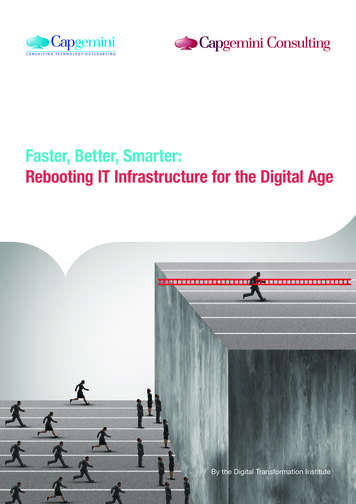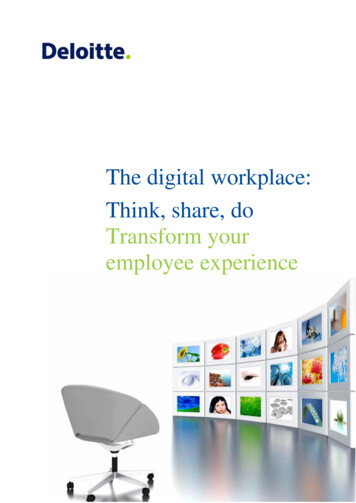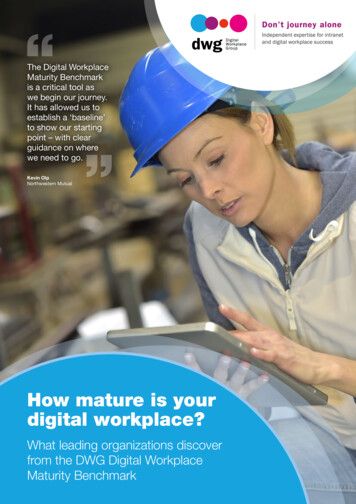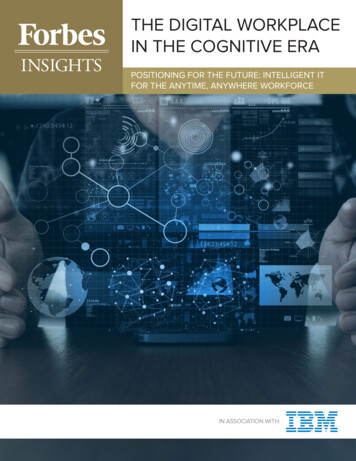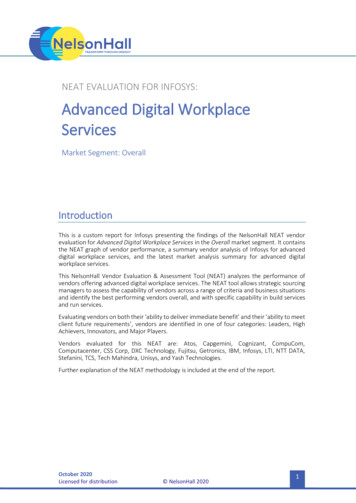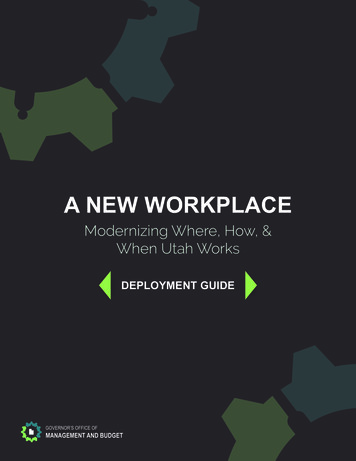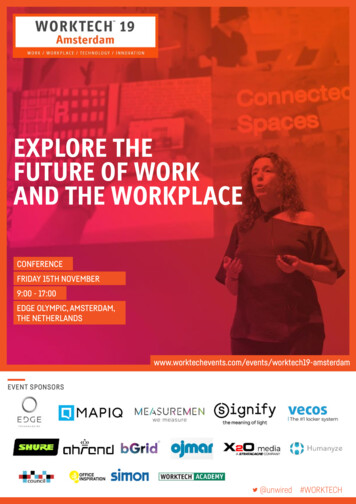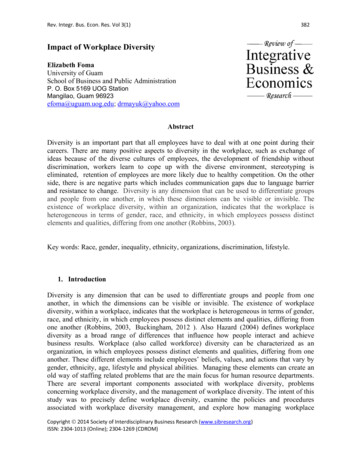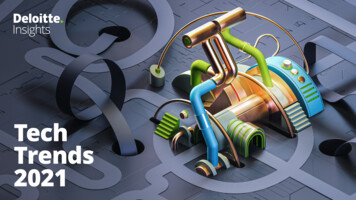
Transcription
TechTrends2021
Rebooting the digital workplaceMEASURE AND MANAGEWORK IN NEW WAYSThe digital workplace’s technologies and toolsData and insights from the digital workplace cancan help employers gain insights that enablehelp organizations improve work processes andthem to identify patterns, make predictions,employee experience to create better outcomes.nudge behaviors, and fine-tune performance.OFFICE OF THE FUTUREAs the office becomes a hub for collaborating,innovating, and meeting, digital technologiescan augment the onsite work experience.116
12345678Rebooting the digital workplace9117TREND 7Rebooting the digital workplaceData can drive new ways of working remotely and in the officeDriven by COVID-19, the abrupt shift toremote work as the default for muchof the labor force has altered work aswe know it. One study found that only 15% ofthose employed pre–COVID-19 worked fromhome; these workers were joined after thepandemic by an additional 35%, suggestingthat fully half of the employed labor force nowworks from home.1With the work-from-home cat out of thebag, it could prove challenging to coax theseprofessionals back to prepandemic levelsof in-office work. Staffing firm Robert Halffound that 60% of professionals who hadtransitioned to a remote setup said theyhave better work/life balance, and that 74%of respondents would like to continue totelecommute more after pandemic restrictionsare eased.2As organizations manage a growing numberof offsite employees—working from home orother nontraditional workspaces—many arebeginning to accept the inevitability of a digitalworkplace where work is completed by a mix ofonsite and remote workers that must operatein synchrony to meet business objectives.Some leaders approach the prospect of thedigital workplace with a number of concerns: Productivity. Distractions and poorsupervision could impede collaborationand derail productivity, and the lack ofsocial support might lead to high employeedissatisfaction and turnover. Relationship building and onboarding.Strong existing relationships typicallyremain so after a remote work transition,but weak ones often erode. And it canbe challenging to virtually cultivate newrelationships and onboard new employees. Development and learning. It could bedifficult for workers to virtually develop andmaintain skills and professional networksthey need to advance. Impact on innovation. The loss ofserendipity—the unexpected andopportune employee interactions that fuelexploration and invention—could have along-term negative impact on innovation.
12345678Rebooting the digital workplace9Companies may be able to overcome thedigital workplace’s deficits and ambiguitiesby more intentionally embracing its positiveaspects, including the data generated byworkers’ tools and platforms. This canhelp organizations optimize individual andteam performance and customize theemployee experience through personalizedrecommendations, enabling remote work tobe far more than a diminished proxy for thetraditional office. And as onsite workspacestools can help employers gain insights rangingfrom individual employee performance toteam-level productivity to companywidemorale, enabling them to identify patterns andmake predictions, nudge positive employeebehaviors, and fine-tune individual, team, andorganizational performance.and headquarters evolve, organizations canuse this data to create thriving, productive,and cost-effective offices that are seamlesslyinterwoven with the remote experience.AI-driven personal productivity assistants andother artificial intelligence (AI) technologiesthat use workforce data to make personalizedrecommendations to optimize performance, andworkflow management solutions that streamlinework processes and automate decision-making,actions, and responses.The digital workplace is moremeasurable and manageableIf it’s true that you can’t manage what youdon’t measure, then the digital workplace iseminently manageable. Its technologies andEnabling technologies include people analyticssolutions that help deliver actionable insights onemployee and team behavior and productivity,On the backend are strong cybersecuritysolutions, such as zero trust architectures (asdiscussed in the chapter Zero trust: Never trust,always verify), along with hybrid and multicloud118environments and services that support secureremote access and scale with flexing workloads.Of Deloitte’s own experience in rapidlyenabling its workforce, unified communicationsinfrastructure lead Aaron Roe notes thatprevious infrastructure upgrades proved theirvalue. “Because we had already moved tocloud-based unified communications, we wereable to migrate the entire firm to remote workin less than four days without overloading ourdata centers,” he says. “And our move to azero trust security model allowed employeesto securely access needed resources withoutusing a VPN.”3On top of these foundational technologies,organizations can layer tools such asorganizational network analysis, whichis currently used to track organizationalinformation flow. Such analysis can help gaugeremote workforce connectivity—for example,identifying isolated employees and measuringinteractions between and among teams.
12345678Rebooting the digital workplace9Workplace social media can help teamstap into the power of the entire workforce,regardless of location, to generate ideas andcollaborate, democratizing formerly privilegedexchanges of ideas. And with researchdemonstrating that videoconferencing’straditional grid of boxes taxes people’s brainsand causes fatigue,4 new videoconferencingsolutions based on virtual and augmentedreality stand ready to enable persistent,simulated collaboration environments—suchthese collaboration tools and seamlesslyintegrate, architect, and use them in acoordinated manner to reduce confusingor repetitive workflows and alerts. Not onlycan this improve team productivity—it canimprove the quality of data and insights thathelp leaders better understand and managetheir employees.as those found in online video games—whereusers can meet, communicate, interact, andcollaborate in a more natural-feeling setting.5to lean into the ongoing move away fromdecision-making based on gut instinct andassumptions. Transparency about how theyplan to use the data—and what they’remeasuring and why—can help organizationsmanage privacy concerns. And rather thanfocus on individual performance, they can aimto identify and bend overarching trendlines byaggregating and anonymizing data.Finally, with collaboration tools nowubiquitous, a collaboration ecosystem strategycan help optimize technology investmentsin chat-based workspaces, video and phoneconferencing, individual and team projectand task management, whiteboarding andbrainstorming, file-sharing and storage, andother tools. This can help enterprises curateMeasuring employees’ digital activity providesan additional opportunity for employers119The next-level ability to measureand manage will drive new waysof workingThe transition to the digital workplace couldfollow a path reminiscent of the evolutionfrom analog LPs to digital CDs and, later, toMP3s and streaming services, which usheredin measurability, portability, scalability, andcountless other benefits. The resulting dataenabled services to suggest songs andartists to users based on previous listeninghabits, creating a better and more tailoredfan experience.Similarly, by understanding data andbehaviors that most closely correlate withworkplace success and failure, companiesstand to improve work processes and createpersonalized employee experiences thatcreate better engagement and outcomes.
12345678The most agile companies will investigatethe patterns remote workers are encoding indata and use them to develop new ways ofworking. As ways of working and collaboratingare standardized, the knowledge that can beextracted from emerging work patterns willbecome more precise and more valuable.If it’s true that youcan’t manage what youdon’t measure, thenthe digital workplace iseminently manageable.Employee engagement and well-being.In a remote situation, managers may beunable to readily identify employees whoare at risk for low productivity or in dangerof leaving. With data generated by the digitalRebooting the digital workplace9120workplace, managers can identify employeessuffering from emotional stress and burnoutand proactively intervene to address suchchallenges as low engagement and lackof inclusivity.6 Psychographic data such asboredom, stress, and fatigue levels can helpleaders better allocate tasks and ensure thatemployees are appropriately challenged andempowered to manage their career goals andbe productive while avoiding burnout.could offer employees assignments predictedto be both interesting and skills-aligned. Thecoach “knows” the skills and experiencesthat each employee needs to be optimallychallenged and makes suggestions to improvebehavior, collaboration, and specialized skills inreal time.Flexible workplace 2.0. Digitization unlocksa new era of workplace customization. Inthe same way that streaming music servicesoffer individual users customized, data-drivenexperiences based on personal tastes, remoteworkforce data and predictive analytics canhelp organizations provide employees withhigh-quality, customized experiences—amix of benefits, rewards, assignments, andlearning based on personal experiences andtacit and explicit preferences. The digital coachof the future—enabled by organizational AI—informal structures that are often moreinfluential than formal organizational design.It could identify workplace relationshipsthat could be proactively developed orstrengthened to foster serendipitous, crossdisciplinary connections that help driveinnovation. Virtual connection-building toolscan nudge contacts between individuals andteams, make customized recommendationsto link employees with mentors and likeminded colleagues, and support onboardingby connecting new hires with teammatesDigital serendipity. Data generated bycollaboration channels can map workerinteractions and relationships, revealing
1234567and peers. Gig platforms, or internal talentmarketplaces, can help connect employeeswith internal and external opportunities,mentorships, stretch assignments, androtation programs and enable managers tofind needed skills.The office is dead, long livethe office!While the office may be undergoing apandemic-driven existential crisis, it’s notdown for the count. (The everyday commute,on the other hand, appears to be on lifesupport.) However, just as e-commercechanged the way consumers and retailersthink about brick-and-mortar storefronts, sois the forced mass adoption of remote workchanging the way employers and employeesthink about the physical workplace.8Rebooting the digital workplace9For example, even though employees desirethe flexibility to work remotely, most aren’tready for an online HQ. In one survey, nearlythree-quarters of workers said they prefer abalance of working at home and in the office.7The primary draw of the office, accordingto another study, is face-to-face humanconnection,8 particularly for millennials andGen Z workers.9While the officemay be undergoinga pandemic-drivenexistential crisis, it’snot down for the count.How do we reconcile these competing needs?The office may not be dead, but it’s unlikely toreturn in its previous incarnation. Employers121could find that creating exciting environmentsthat employees are eager to experienceis the best way to entice them back to theoffice. Perhaps, as architecture and designfirm Gensler predicts, the post–COVID-19workplace will shift from a place where peoplework to a place where teams meet, socialize,and connect.10The smart money is on flexible andconfigurable work environments, technologydriven workplace services, and new waysof managing fewer people and less spacewithout sacrificing collaboration andinnovation. As the office evolves to becomeboth a collaboration hub for project teamsand a creative center for client meetings,employees can expect a hybrid work stylethat supplements working from home withtargeted in-office experiences, especiallyfor critical events such as onboarding. Andwhile coworking spaces took an immediateoccupancy hit when COVID-19 first struck, in
12345678the long term, they could be a more flexible,less expensive office alternative for businessesthat are canceling or renegotiating their leases.Offices of the future will likely be infused withthe same digital technologies and tools used inthe remote workspace. The same capabilitiesthat enable a personalized employeeexperience in the digital workplace can similarlyaugment the physical workplace experience.The office will likely be retooled to more easilypermit virtual, multidirectional collaborationwith remote workers. For example, in Deloitteoffices, all conference rooms, phone rooms,and other closed-door meeting spaces willbe enabled for video with platform-agnosticvideoconferencing solutions that integrate allleading applications. Teams are exploring howtechnologies can create parity of experiencebetween people meeting in the office andremote participants. Deloitte’s boardroom,featuring individual cameras with advancedRebooting the digital workplace9optics and noise-canceling microphones ateach seat to provide remote attendees with amore realistic experience, serves as a modelfor how such parity might be achieved.Organizational AI can help teams organizethe dates, times, and locations of in-officemeetings to maximize the value of spaceand promote team interactions. And withgood office design, companies can measurethe impact of traditional office orthodoxiessuch as in-person conversations, watercooler discussions, and spontaneous hallwayencounters that generate real business value.Yet the return on investment for the officeof the future will likely be more carefullyexamined than it has in the past.The way forwardIn the wake of the mass forced adoptionof remote work, many organizations are122considering how to configure and manage adigital workplace in which work is completedby both remote and onsite workers. The datagenerated by workers’ tools and platformscan help organizations fine-tune individualproductivity and team performance, delivercustomized employee experiences, andoptimize the use of office space. As employeesreturn to the office, this data can also helpremote and onsite teams work in concertand ensure the parity of remote and in-officeemployee experiences.
12345LESSONSFROM THEFRONT LINES6789New tools, good timing supportremote work rolloutNew tools and good timing helped Thomson Reuters navigatethe pandemic-driven shift to remote work, says Rob NewnesSmith, CTO of digital, employees, and partners for thebusiness information services and global media company.11When the majority of its 25,000 employees began workingfrom their homes in March 2020, Thomson Reuters wasputting the finishing touches on a major global rollout ofcloud-based enterprise systems and platforms, includingcollaboration and productivity tools that made it easier foremployees to quickly adapt to remote workflows andmaintain productivity.A significant portion of Thomson Reuters employees wereaccustomed to periodic virtual work, but these previousexperiences provided only partial insights into the impactof long-term remote work and lockdown isolation on wellbeing, especially when other factors such as home-schoolingand care for elderly relatives were in play. Company leadersrecognized the importance of extending the corporate cultureRebooting the digital workplace123to the home workplace. The use of videoconferencing toolsbecame the norm for daily meetings while the use of deskphones faded. In many cultures, a deep-rooted sense offormality toward behavior in the work environment madesome employees feel awkward about the casualness ofworking from home. Team leads cultivated authenticity andcompassion by modeling more relaxed attire and the use ofhome areas not typically seen as office space, with perceivederosion of boundaries such as videoconference interruptionsby children or pets.Having successfully enabled its employees to be productivein the remote work environment, Thomson Reuters isworking to define the postpandemic workplace experience.Its well-timed modernization of enterprise systems puts thecompany in a good position to adapt to “the next normal”with access to personalized, consumable information,improved use of automation and AI to complement selfservice functionality, and richer levels of insights availablefor the executive leadership team. Newnes-Smith envisionsemployees routinely dividing their time between regional hubsand their home offices so that they can enjoy the best of bothworlds: face-to-face collaboration, socializing, and unplanned
12345678interactions along with the flexibility oftelecommuting to create an improved work/life balance.Moving forward, the Thomson Reuters HR, realestate, and technology teams are deliberatelyreenvisioning in-office technologies, includingintegrated communication and collaborationplatforms, new tools such as smartwhiteboard technology, idea managementsoftware to crowdsource innovative ideasfrom employees, predictive talent insights,automation of key talent acquisition baseprocesses, and AI-based tooling as part ofa new learning system platform. “We planto leverage our collaboration platforms tocreate a frictionless, seamless experience asemployees move between their chosen placesof work,” he says.Ensuring equity between in-office and athome work experiences is critical. As we moveinto the ninth month of COVID-19, ThomsonRebooting the digital workplace9Reuters continues to hone its use of variouscollaboration tools to ensure employees’voices are heard and faces are seen. “Wheneveryone is an equal square on a screen,”Newnes-Smith says, “it has a way of levelingthe interaction, whether you’re located athome, in an airport, or in the office.”Lloyd’s of Londonaccelerates innovation withvirtual underwriting roomWhen the COVID-19 pandemic hit the UnitedKingdom, Lloyd’s of London—the renownedcommercial insurance marketplace thatintermediates between clients, underwriters,brokers, and insurance companies—closed itsmarket floor, known as the underwriting room.From their hastily set up home offices, brokersand underwriters transitioned from in-persondeal-making to electronic trading.124It was a dramatic change for participants inthe insurance market, which had never in its330-year history halted in-person trading.12Traditionally, the four-story underwritingroom is a bustling trading hub packed withinsurance brokers and underwriters whoconduct face-to-face meetings to negotiatedeals between policy buyers and sellers. On ausual day, the underwriting room hosts about5,000 market participants; around 45,000people have badges to enter. “Historically, themarket floor is the heart of Lloyd’s. Business isgrounded in the physical space, where brokerswalk the market floor and wait in queues tosee which underwriters are at their boothsand whether they might be interested ininsuring a particular risk,” says product ownerSam Irving. “COVID-19 was a monumentalevent because it completely disrupted thesewell-established workflows.”13As Lloyd’s worked toward a phased Septemberreopening, leaders looked to leverage digital
12345678technologies to make connecting moreoperationally resilient, instead of simplyreturning to business-as-usual in the physicalunderwriting room. “This wasn’t a completelynew idea for us, but the pandemic’s challengeto the old ways of working really acceleratedour thinking,” Irving says.Leaders decided to develop a virtualunderwriting room that would complementLloyd’s’ in-person counterpart. This meantidentifying gaps in the existing electronictrading experience, such as the ability toschedule on-the-fly meetings, ask and answerquick questions, and meet spontaneously—the hallmarks of the market floor. The goalwas not only to improve the current workfrom-home experience but to leverage thoselearnings to improve the traditional in-persontrading process.On an accelerated timeline—and backed byan extensive research and design processRebooting the digital workplace9125that centered the needs of brokers andunderwriters—Lloyd’s established a virtualroom that connects brokers and underwritersvia digital collaboration platforms, enablingthem to schedule trading conversations withcolleagues in different locations around theworld. The virtual room includes searchablebroker and underwriter profiles and a marketdirectory, availability settings, and flexible chatfunctionality. This allows brokers to search forunderwriters by specialty, view underwriterand supportive experiences whether the useris trading remotely or on the market floor.For example, the market directory improvesthe efficiency of brokers in the physicalunderwriting room by enabling them to checkunderwriters’ availability without walkingaround the market floor, and as marketprofiles develop, this could help brokersconfirm underwriter interest in potential dealswithout standing in queue.profiles, see who’s free for an immediate chat,and schedule meetings or videoconferences.The market directory and profiles helpunderwriters promote themselves byproviding more visibility into the types ofopportunities they’re seeking.An unintended benefit of the virtual roomis that publishing users’ availability can aidtheir work/life balance. “Working from homeremoved the traditional end-of-the-dayboundary of physically leaving the marketfloor and going home, and people routinelycontacted each other on their mobile phonesduring nonwork hours,” Irving explains.“Setting their availability gives remote usersmore control over developing and maintainingwork/life boundaries.”Lloyd’s unveiled its virtual underwritingroom to selected users in tandem with theSeptember reopening of the market floor. Thegoal is for the virtual and physical rooms towork in synergy and provide equally efficient
12345678Lloyd’s continues to build on the initiallaunch of the virtual underwriting room,adding and improving features and releasingimprovements weekly. Top priorities for thefuture include virtual queuing, integratedcalendars, and mobile applications.Human-centric technologycritical to workplaceredesign and workforceperformanceCOVID-19 has made a permanent imprint onthe way workplaces operate, forever changinghow people work—and where they work.Many business leaders are trying todetermine how these new ways of workingwill affect their organizations—and their realestate portfolios. Commercial real estateservices company JLL, which has long trackedtrends in workplace strategies, design, andRebooting the digital workplace9technologies, expects the road to the “nextnormal” to be fluid and complex.COVID-19 has accelerated the transformationof the workplace by five to 10 years, saysMarie Puybaraud, JLL’s global head ofcorporate research, who specializes inthe study of human performance and thehuman experience at work.14 “The distributedworkforce that we’re seeing now was alwaysgoing to happen, but we were expecting aslower evolution,” she says. “The pandemicsimply sped up the timeline.”JLL’s research shows that high-performingworkers have flexible work hours andremote work opportunities—but that duringlockdowns, these high performers missedbeing in the office more than others. “Whileremote work seems to have a positive effecton performance, workers are not ready toabandon the office, because collaborationwith colleagues and the ability to manage or126feel supported waned during the pandemic,”Puybaraud says. “Therefore, we don’t expectoffice environments to retain traditionaldesigns. We have a flexible workforce, and wewill need workplaces to be equally adaptable.”For example, instead of a single corporate HQ,a business might have multiple smaller officesthat are geographically distributed to maximizeavailable talent pools, with employees dividingtheir time between home, corporate offices,and other co-working places. Puybaraud seesthis as the New Golden Age of the Worker—and sees a worker-centric approach as criticalin redesigning these workplaces.Nearly half of workers who participated in arecent JLL survey say they desire offices withdedicated areas for socializing, connecting tonature, and learning, as well as doing focusedwork. Typically, however, about two-thirdsof space in today’s office environments isreserved for individual work, with only around
12345678a third set aside for collaborative purposes. Tomeet the needs of the future workforce, theseproportions likely will need to flip, with roughlythree-quarters of the workspace for collectiveuse and the rest set aside for individual work.This likely will require businesses tosignificantly retool and redesign their officeenvironments to meet workforce preferencesand reenvision the workplace as a social hubto boost human experience and performance.JLL is exploring how artificial intelligence,virtual and artificial reality, 3D modeling,and other technologies can help push thebuilt environment beyond its current limits.Besides transforming the physical workspace,technology can enable the dispersedworkforce to collaborate and innovateeffectively. For example, future technologyplatforms need to enable those who aren’tphysically present in future collaborationspaces to interact naturally and productivelywith those who are.Rebooting the digital workplace9The success of the mass work-from-homeexperiment conclusively proved the valueof technology, Puybaraud says. “Technologyestablished itself as a successful enabler ofremote work. By and large, businesses wereable to continue to operate efficiently becauseof technology platforms. However, withemployees dispersed among multiple officelocations and home offices, companies willprobably need to expand those platforms aswe move forward. There is a lot of opportunityfor new solutions that deliver more realistic,engaging, human-centric experiences. Whilenothing can replace the real-world interactionsthat most people crave, technology can makeinteractions between on-site and remotecolleagues even more efficient.”127
123456789MY TAKEDan TorunianVice president, employeetechnology and experiencesand data centers, PayPalRebooting the digital workplace128When COVID-19 caused PayPal to moveour 23,000-plus employees from 90 onsitelocations to a work-from-home model, ouremphasis evolved from ensuring their safetyto improving efficiency.But as it became clear that the workforce would remain offsite forthe foreseeable future, we shifted our focus, using the rapid moveto remote work as an opportunity to reexamine the ways we worktogether in teams and as a company.To achieve our business goals and continue to provide a world-classexperience to all employees—whether onsite or offsite—we aredeveloping new ways of working and collaborating. Our goal is toenable the workforce to be productive in terms of velocity and outputwhile also promoting learning, innovation, and collaboration. And wewant to help employees address some of the fundamentally human
1234567challenges of working away from thecorporate office.Before the pandemic, work processes,collaboration tools, communication channels,learning opportunities, and culture—eventhe way we socialized with colleagues—werenecessarily optimized for the traditionalworkplace. For example, about half of ouremployees work in operational roles incustomer service, collection, and fraud.Before the pandemic, they worked in highlycontrolled, metrics-oriented call centers;their colleagues were all within arm’s reach.COVID-19 required us to evaluate thesustainability of such traditionally designedteams. Now, these same employees areworking solo—or with roommates, spouses,and children—in unstructured home-officeenvironments. They’re still meeting theirproductivity goals, but with new challengesrelated to communicating, collaborating,skill-building, and networking as well as such8Rebooting the digital workplace9inherently human challenges as sustainingsocial connections with colleagues, managingfamily members during work hours, andmaintaining work/life balance. The digitalworkplace requires employers to reengineerthe way their people connect, communicate,collaborate, and support each other withinand across various functional areas.With most or all employeesoperating from theirhomes, it’s incumbentupon employers to optimizeremote worker experiences,intentionally evolving them tobe as efficient and delightfulas onsite experiences are.129With most or all employees operating fromtheir homes, it’s incumbent upon employersto optimize remote worker experiences,intentionally evolving them to be as efficientand delightful as onsite experiences are.Moving forward, for example, we’re looking forways to tailor the digital collaboration process:We’re exploring how to deliver the samecapabilities and experiences across multiplecollaboration platforms so that eachemployee can work with others using theirpreferred tools.Employers can also identify and nurture localand regional working norms, differences inIT infrastructure, and technology preferencesthat could affect employee work styles andprocesses. For instance, bandwidthcapacity, internet support, and networkcapabilities, along with cultural differencesin attitudes toward working from home, varyamong regions. Understanding andadapting to such factors can help companies
12345678further differentiate and customize theemployee experience.It’s also important to capture the naturalfeeling of tapping a colleague on theshoulder and spontaneously grabbing acoffee—a feeling that’s missing from formalvideoconference invitations. To help withthis, we created an app that randomly pairsinterested employees for virtual coffee breaks.We envision expanding it to create a virtualenvironment where users feel as thoughthey’re enjoying coffee together in theirfavorite c
The digital workplace's technologies and tools can help employers gain insights that enable them to identify patterns, make predictions, nudge behaviors, and fine-tune performance. As the office becomes a hub for collaborating, innovating, and meeting, digital technologies can augment the onsite work experience. Data and insights from the .


